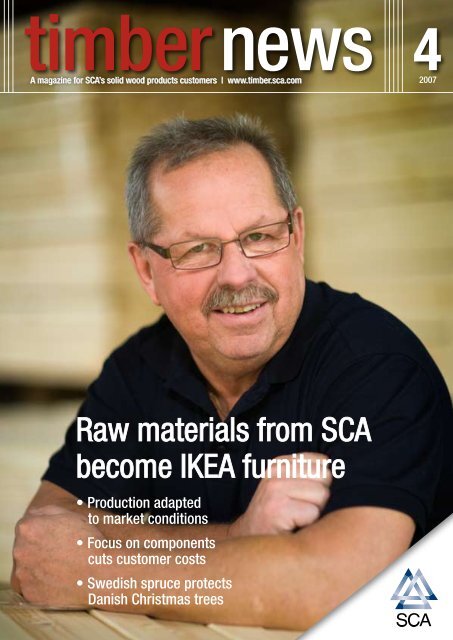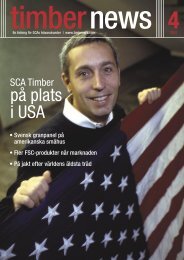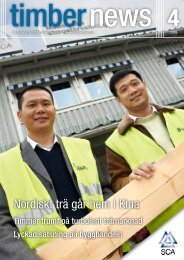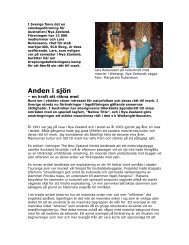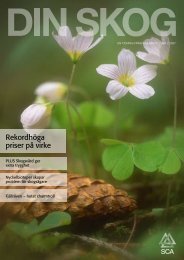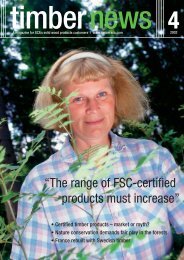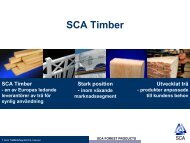Raw materials from SCA become IKEA furniture - SCA Forest ...
Raw materials from SCA become IKEA furniture - SCA Forest ...
Raw materials from SCA become IKEA furniture - SCA Forest ...
You also want an ePaper? Increase the reach of your titles
YUMPU automatically turns print PDFs into web optimized ePapers that Google loves.
timbernews<br />
A magazine for <strong>SCA</strong>’s solid wood products customers | www.timber.sca.com<br />
42007<br />
<strong>Raw</strong> <strong>materials</strong> <strong>from</strong> <strong>SCA</strong><br />
<strong>become</strong> <strong>IKEA</strong> <strong>furniture</strong><br />
• Production adapted<br />
to market conditions<br />
• Focus on components<br />
cuts customer costs<br />
• Swedish spruce protects<br />
Danish Christmas trees
timber news<br />
Dick Bergh, president of<br />
Hedlunda Industri AB, Lycksele, Sweden.<br />
Cover photo: Michael Engman<br />
<strong>SCA</strong> Timber to<br />
scale down production<br />
3<br />
<strong>Raw</strong> <strong>materials</strong> <strong>from</strong> <strong>SCA</strong><br />
<strong>become</strong> <strong>IKEA</strong> <strong>furniture</strong><br />
6<br />
Strategeic move towards<br />
more component production<br />
8<br />
Flying start to 2008<br />
10<br />
Pressure on the solid wood<br />
products market<br />
11<br />
Spruce <strong>from</strong> <strong>SCA</strong> protects<br />
Danish Christmas trees<br />
12<br />
<strong>SCA</strong> Timber, <strong>SCA</strong>’s solid wood<br />
operation, covers eight sawmills and<br />
six planing mills. The total annual volume<br />
of solid wood products amounts<br />
to 1.8 million cubic metres.<br />
Solid wood operations are included in<br />
<strong>SCA</strong>’s <strong>Forest</strong> Products business area.<br />
TimberNews <strong>SCA</strong> <strong>Forest</strong> Products AB<br />
SE-851 88 Sundsvall<br />
tel +46 60 19 30 00<br />
www.timber.sca.com<br />
Timber News is published<br />
four times a year<br />
Editor-in-chief Björn Lyngfelt<br />
Production Fryklunds<br />
Repro & printing Tryckeribolaget<br />
Subscribe to Timber News, please<br />
contact ingrid.lofqvist@sca.com<br />
We all benefit <strong>from</strong><br />
a stable market<br />
In many ways, 2007 will be seen as a record<br />
year for both <strong>SCA</strong> Timber and the entire solid<br />
wood products industry. We have enjoyed<br />
record-breaking levels of production and deliveries,<br />
resulting in a record-breaking profit.<br />
The reason for this upturn is the boom currently<br />
being experienced by the majority of<br />
our most important markets. Construction<br />
activity is high. Huge demand for raw <strong>materials</strong>,<br />
especially <strong>from</strong> Asia, has forced up the prices of<br />
competing <strong>materials</strong> such as steel, plastic and aluminium,<br />
making solid wood products cheaper by<br />
comparison.<br />
Last year, and during the first six months of<br />
2007, the market was characterised by a lack of<br />
solid wood products of a Nordic origin. Customers<br />
have submitted their orders well in advance in<br />
order to be sure they get the products they need.<br />
They have also taken a long-term view due to the<br />
major risk of prices going even higher.<br />
The positive character of the solid wood products<br />
market has encouraged sawmill companies to<br />
increase production. Access to raw <strong>materials</strong> was<br />
proving to be a limiting factor, but storm felling<br />
and record-high sawlog prices have led to a glut of<br />
raw <strong>materials</strong> becoming available, and to production<br />
increasing substantially.<br />
We reached an equilibrium during August. Sawmill<br />
stocks began to increase and customers came<br />
to the realisation that products would be available<br />
when they needed them and that, in all probability,<br />
they would not get any more expensive. If customers<br />
go <strong>from</strong> ordering two months in advance to<br />
ordering one month in advance, the effects are<br />
quite dramatic.<br />
That’s why <strong>SCA</strong> Timber is now trying to adapt<br />
to market conditions. We’re scaling down production,<br />
mainly during the first quarter. Ideally, this<br />
move will focus on production based on imported<br />
raw <strong>materials</strong>, which are expensive and don’t<br />
always satisfy the quality requirements our customers<br />
impose on their products. In addition,<br />
notification we have received concerning export<br />
duty and other obstacles have cast doubt on the<br />
extent to which imported sawlogs will be available<br />
in the future.<br />
Ulf Larsson, president of <strong>SCA</strong> Timber.<br />
Photo: Per-Anders Sjöquist<br />
We will continue to develop our sawmills, but we<br />
will do so using raw <strong>materials</strong> we can obtain <strong>from</strong><br />
the region, an approach that fits in well with our<br />
product range and the quality requirements of our<br />
customers.<br />
Not only is it in our interests to have production<br />
in balance with demand, it is also in the interests<br />
of our customers. We will continue to develop the<br />
collaborative relationship we have with our customers,<br />
to develop products that meet their requirements<br />
and, by working closely with them,<br />
increase the value of those products and slash the<br />
costs of the supply chain. A disjointed market<br />
with massive price fluctuations and periods when<br />
it is difficult to obtain products benefits neither us<br />
nor our customers. Ploughing time and resources<br />
into ensuring that products are available one<br />
month and being on the hunt for low prices the<br />
next, takes away the focus <strong>from</strong> our most<br />
important business – ensuring that the wood<br />
<strong>become</strong>s a product for an end customer.<br />
That is the business that we must work together<br />
to develop. The potential for wood to take market<br />
shares <strong>from</strong> other <strong>materials</strong>, and to find other areas<br />
of use, is good. Together, we must find ways of<br />
exploiting this potential to its fullest extent.<br />
Ulf Larsson<br />
President, <strong>SCA</strong> Timber<br />
timbernews | 2
<strong>SCA</strong> Timber to scale down production<br />
<strong>SCA</strong> Timber is set to implement a series of measures that will<br />
reduce its production of sawn solid wood products by almost 15<br />
percent during the first quarter of 2008 compared to this year’s<br />
production level. In addition to production cutbacks at the Munksund<br />
and Rundvik sawmills, all sawmills will stop for an extended<br />
break over Christmas and New Year. A ban on overtime will also be<br />
implemented.<br />
“<br />
For the past two years, demand<br />
for solid wood products in<br />
our product segments has<br />
outstripped supply,” says Ulf Larsson,<br />
president of <strong>SCA</strong> Timber.<br />
“Although the underlying consumption<br />
of wood products remains<br />
high, an exceptionally high<br />
level of production in the sawmills<br />
in Scandinavia and on the continent<br />
is acting as the catalyst for<br />
many customers to play a waiting<br />
game when placing their orders.”<br />
Once Munksund Sawmill adapts its production level to the availability of domestic raw material, one of the<br />
sawmill’s two trimming mills will be decommissioned.<br />
Photo: Per Pettersson<br />
In order to adapt production to<br />
the prevailing level of demand,<br />
<strong>SCA</strong> Timber has decided to scale<br />
back its production. At Munksund<br />
Sawmill outside Piteå in<br />
northern Sweden, the older of the<br />
two trimming mills is being shut<br />
down, reducing production by<br />
40,000 cubic metres of pine solid<br />
wood products. At Rundvik Sawmill,<br />
production is being reduced<br />
by some 70,000 cubic metres of<br />
spruce solid wood products. These<br />
cutbacks will see the number of<br />
people employed at Munksund<br />
fall by ten, whilst Rundvik will<br />
see a drop of just over 20.<br />
“Munksund and Rundvik have<br />
both been partially supplied with<br />
imported sawlogs,” says Larsson.<br />
“The price of this raw material<br />
has increased dramatically and<br />
we believe that in the future it will<br />
constitute an unreliable and<br />
unpredictable raw <strong>materials</strong> base,<br />
both in terms of availability and<br />
cost. That’s why we’ve come to<br />
the decision to phase out the use<br />
of imported raw <strong>materials</strong> and to<br />
base the future development of<br />
our sawmill operations on raw<br />
<strong>materials</strong> we can obtain within<br />
the region. We’re endeavouring to<br />
increase our procurement of sawlogs<br />
<strong>from</strong> sources in northern<br />
➔<br />
3 | timbernews
“We’re focusing on strengthening our in-house sawlog procurement<br />
organisation, ensuring that we’ll be well equipped<br />
once the order landscape <strong>become</strong>s stable again,” says Anders<br />
Nordmark, sawmill manager at Munksund.<br />
Photo: Per Nilsson<br />
Sten Olov Andersson, sawmill manager at Rundvik, believes<br />
that it is important to increase the procurement of raw <strong>materials</strong><br />
<strong>from</strong> northern Sweden.<br />
Sweden as it is a raw material that<br />
fits both our range of products<br />
and the stringent quality demands<br />
of our customers.”<br />
In addition to these cutbacks,<br />
<strong>SCA</strong> Timber will be stopping production<br />
in all sawmills over the<br />
Christmas and New Year holidays.<br />
Furthermore, a ban on overtime<br />
or other non-standard operating<br />
times will also be introduced.<br />
Taken together, these measures<br />
will reduce production levels by<br />
almost 15 percent, equivalent to<br />
55,000 cubic metres, during the<br />
first quarter.<br />
“We’re implementing these measures<br />
quickly to adapt to what we<br />
believe to be a temporary period<br />
of uncertainty in the market,” says<br />
Larsson. “Consumption of solid<br />
wood products is high and competing<br />
<strong>materials</strong> have increased<br />
significantly more in price in<br />
recent years. In my opinion, we<br />
will soon have a stable order<br />
book and market prices will have<br />
settled down, benefiting both<br />
customers and producers in the<br />
long term.”<br />
Rundvik is one of the two sawmills<br />
to be most affected by the<br />
changes. In the past two years,<br />
demand for the sawmill’s products<br />
has sky-rocketed. Large volumes<br />
of solid wood products have<br />
been supplied to customers in<br />
Scandinavia, France, the Netherlands<br />
and the UK. The sawmill’s<br />
planing facility has sold almost<br />
70,000 cubic metres of processed<br />
solid wood products to Home<br />
Depot and other customers in the<br />
US.<br />
“The facility in Rundvik has<br />
therefore been pushed to the limit,”<br />
claims Sten Olov Andersson, sawmill<br />
manager at Rundvik. “We’ve<br />
been running an extra shift and<br />
have operated at full production<br />
for the entire summer to keep up<br />
with the demand for our products.<br />
We’ve even introduced a nightshift<br />
to cope with demand.”<br />
At present, production at Rundvik<br />
stands at around 240,000<br />
cubic metres of spruce sawn solid<br />
wood products, of which 80,000<br />
cubic metres are planed. The sawmill<br />
employs around 140 people,<br />
including contractors.<br />
However, in the last 12 months<br />
the sawmill has been periodically<br />
affected by production disruption<br />
caused by difficulties in acquiring<br />
sufficient volumes of raw material.<br />
It has been possible to maintain<br />
a substantial proportion of<br />
the production increase of recent<br />
years by increasing the amount of<br />
sawlogs imported <strong>from</strong> Russia.<br />
However, the recent explosion in<br />
Russian export tariffs means that it<br />
is no longer economically viable to<br />
continue to rely on sawlogs <strong>from</strong><br />
that part of the world.<br />
“At the moment, duty on sawlogs<br />
<strong>from</strong> Russia stands at € 10<br />
per cubic metre. In April next year,<br />
that figure will rise to € 15, and<br />
on 1 January 2009 it will be € 50<br />
per cubic metre,” says Andersson.<br />
“That will close the woodshed<br />
door permanently.”<br />
Once the import of Russian sawlogs<br />
has been phased out, production<br />
of sawn solid wood products<br />
will be reduced by 70,000 cubic<br />
metres to 170,000 cubic metres.<br />
This will also see production move<br />
<strong>from</strong> a three-shift rotation to a<br />
two-shift rotation during 2008.<br />
“Unfortunately, we will also<br />
be forced to let 20 or so people<br />
go, something that will naturally<br />
be a blow to those affected,” says<br />
Andersson, emphasising that the<br />
cutbacks are being undertaken<br />
<strong>from</strong> a production level that has<br />
not been exceeded at any time<br />
during the past 30 years.<br />
Munksund sawmill has also announced<br />
that it will be implementing<br />
production cutbacks, starting<br />
at the beginning of the new year.<br />
“Throughout this year, we’ve<br />
experienced major problems in<br />
getting our hands on sufficient a-<br />
mounts of raw material,” says saw-<br />
timbernews | 4
mill manager Anders Nordmark.<br />
This year, Munksund has produced<br />
approximately 400,000<br />
cubic metres of pine solid wood<br />
product and employs 130 people.<br />
The amount of custom and processed<br />
products leaving the mill<br />
stands at 200,000 cubic metres. Its<br />
most important markets are Scandinavia,<br />
the UK, Japan and Italy.<br />
“We get almost 30,000 cubic<br />
metres of pine raw material by<br />
boat <strong>from</strong> Russia, which we are<br />
now in the process of phasing<br />
out,” says Nordmark. ”Replacing<br />
this much wood with raw material<br />
sourced in the local region in the<br />
short term is difficult.”<br />
the availability of domestic raw<br />
<strong>materials</strong>, reducing output by approximately<br />
40,000 cubic metres,<br />
the older of the sawmill’s two<br />
trimming mills is being decommissioned.<br />
This means that ten<br />
people will be made redundant.<br />
“We’re now focusing on<br />
strengthening our in-house sawlog<br />
procurement organisation, ensuring<br />
that we’ll be well equipped<br />
once the order landscape <strong>become</strong>s<br />
stable again,” says Nordmark in<br />
summary.<br />
Mats Wigardt<br />
Once the import of sawlogs <strong>from</strong> Russia is phased out, the<br />
production of sawn solid wood products at Rundvik will be<br />
reduced. This will see the current three-shift rotation being<br />
replaced by a two-shift rotation during 2008.<br />
Photo: Bo Fernström<br />
In conjunction with adapting the<br />
production level at Munksund to<br />
5 | timbernews
Transforming <strong>SCA</strong> raw <strong>materials</strong> into<br />
<strong>IKEA</strong> <strong>furniture</strong><br />
For more than 20 years, Hedlunda Industri of Lycksele,<br />
northern Sweden, has supplied pine <strong>furniture</strong><br />
to <strong>IKEA</strong>. In order to meet increased demand, a<br />
further £3.8 million has been ploughed into new<br />
production equipment. One of the company’s important<br />
collaboration partners is <strong>SCA</strong>, which provides<br />
close to 40 percent of the raw <strong>materials</strong> used.<br />
Coming onto the workshop<br />
floor at Hedlunda Industri is<br />
like paying a visit to Santa’s<br />
grotto.<br />
At one end of the massive factory<br />
space, sawn pine timber <strong>from</strong><br />
sources such as <strong>SCA</strong>’s sawmills in<br />
Munksund and Bollstabruk is<br />
unloaded <strong>from</strong> the loading bay.<br />
More than 130,000 linear metres<br />
– around 500 cubic metres – pass<br />
through the cutting line every<br />
week, all cut to precise specifications.<br />
Short pieces are finger<br />
joined to suitable lengths – almost<br />
nothing is wasted.<br />
The raw material is then processed<br />
further by skilled craftsmen<br />
who plane, drill, surface treat and<br />
pack, resulting in a range of pine<br />
shelving and beds. The products<br />
are shipped to <strong>IKEA</strong> stores in<br />
Sweden, the US, Europe and the<br />
rest of the world.<br />
“Obviously, we’re regarded as<br />
being fairly competitive,” says factory<br />
manager Anders Persson, who<br />
acts as our guide around the workshop.<br />
The factory is a fast-paced environment.<br />
Many of the machines<br />
used have been specially built onsite<br />
to replace heavy and labour<br />
intensive processes. One machine<br />
screws and glues bed sides, a<br />
second machine fits the rails to<br />
a shelf and attaches a packet of<br />
screws, whilst a third screws 62<br />
screws into a bed end.<br />
“That was something that used<br />
to be done by hand,” says Persson.<br />
“The guys who had that job didn’t<br />
need to go to the gym after<br />
work!”<br />
Given the large volumes and<br />
small margins associated with this<br />
type of work, it is important to<br />
employ a carefully considered flow<br />
in the manufacturing process.<br />
According to Persson, he really<br />
had to rack his brains before he<br />
could finally implement a process<br />
that satisfied the stringent precision<br />
and quality requirements<br />
imposed by customers.<br />
“And we’re going to get better<br />
and faster,” he assures us.<br />
On a slow-moving conveyor belt,<br />
flat packs are filled with finished<br />
components. Not one single pack<br />
of screws may be forgotten. The<br />
<strong>furniture</strong> is test assembled at regular<br />
intervals to ensure that there<br />
are no defects.<br />
“One of the packs contains<br />
timbernews | 6
around 40 different components,”<br />
says Persson. “The entire system is<br />
based on ensuring that no component<br />
ends up in the wrong place.”<br />
Finished packs are then driven<br />
out by forklift to the warehouse<br />
before being shipped out to destinations<br />
across the world. Every<br />
day, five railway wagons are filled<br />
with <strong>furniture</strong> <strong>from</strong> Hedlunda<br />
Industri, as well as a number of<br />
trucks. The railway line runs all<br />
the way to the integrated loading<br />
bay and was built solely for this<br />
purpose.<br />
“Logistics is one of our strong<br />
suits,” says Persson, moving out<br />
of the way of fully loaded truck<br />
heading for the open door of the<br />
railway wagon.<br />
Compared to the hive of activity<br />
out on the factory floor, the office<br />
is a much more tranquil environment.<br />
Dick Bergh, together with a<br />
partner, set up the factory in Lycksele<br />
back in 1984. From the outset,<br />
<strong>IKEA</strong> was an important collaborative<br />
partner. Since then, the<br />
business has gradually grown and<br />
developed and now employs 95<br />
people with a turnover of £11.5<br />
million. Hedlunda Industri is now<br />
a family-run company, with Dick<br />
Bergh as its president and his two<br />
sons, Jonas and Mathias, as partners.<br />
“We recently signed a long-term<br />
agreement with <strong>IKEA</strong> that will see<br />
us invest another £3.8 million in<br />
the business up until 2012,” says<br />
Bergh. “We’ll also be increasing<br />
our staff to approximately 160<br />
employees.”<br />
More efficient planing lines,<br />
increased finishing capacity, automation<br />
of production and mechanising<br />
the packing process are just<br />
a few of the measures that will be<br />
implemented. In addition, the company<br />
will also extend its organisation<br />
and acquire leading-edge<br />
expertise in production technology<br />
and logistics.<br />
“<strong>IKEA</strong> is an incredibly straighttalking<br />
customer,” continues Bergh.<br />
“They know what they want, when<br />
they want it and how they want it.<br />
It’s then just up to us to deliver on<br />
our promises.”<br />
The expansion of Hedlunda<br />
Industri will also have consequences<br />
for the volume of raw<br />
<strong>materials</strong> required. Bergh has<br />
held discussions with a number of<br />
sawmills, including <strong>SCA</strong>’s mills in<br />
Munksund and Bollstabruk, with<br />
the aim of doubling their current<br />
“The majority of our raw <strong>materials</strong><br />
requirement will be satisfied by <strong>SCA</strong>,”<br />
says Dick Bergh, president of<br />
Hedlunda Industri AB in Lycksele.<br />
supply. The longer-term aim is also<br />
to be able to buy more processed<br />
products <strong>from</strong> the sawmills.<br />
“We see our collaborative relationship<br />
with <strong>SCA</strong> as one that is<br />
fundamentally sound and can be<br />
built on for the long term,” summarises<br />
Bergh. “This means that<br />
the majority of our raw <strong>materials</strong><br />
requirement, around 40 percent,<br />
will be satisfied by <strong>SCA</strong>.”<br />
Mats Wigardt<br />
Photo: Michael Engman<br />
Company facts:<br />
Founded on<br />
2 January 1986<br />
Family-owned since 2003<br />
Biggest customer is <strong>IKEA</strong><br />
President: Dick Bergh<br />
Turnover: £11.5 million<br />
95 Employees<br />
News: About to embark on<br />
a £3.8 million investment<br />
programme<br />
www.hedlunda-industri.se<br />
The company manufactures shelving and beds that are then sold by <strong>IKEA</strong> throughout the world.<br />
7 | timbernews
Strategeic move towards<br />
more component production<br />
For <strong>SCA</strong> Timber, product development is a strategic<br />
objective. Traditional sawn timber in standard<br />
Nordic grades and multiple lengths will gradually<br />
be phased out and replaced by specialised timber<br />
for industry – or have value added by being turned<br />
into finished products for builder’s merchants.<br />
The component line investment<br />
project recently rolled out at<br />
Tunadal sawmill echoes company<br />
strategy. The new line will<br />
have a capacity of approximately<br />
30,000 cubic metres of door and<br />
window shutter components. The<br />
line will come online in May 2008,<br />
the plan being to reach full capacity<br />
sometime in the autumn of that<br />
year.<br />
Components are nothing new<br />
to <strong>SCA</strong> Timber. In recent years,<br />
we have gradually built up both<br />
our knowledge and supply. <strong>SCA</strong><br />
Timber is already the largest Scandinavian<br />
supplier of developed<br />
timber (including components) to<br />
French industry. Ongoing investment<br />
will enable us to further<br />
increase the volume of these components<br />
and at the same time<br />
lower the production cost.<br />
In 2006, the volume of components<br />
sold into France doubled,<br />
reaching approximately 11,000<br />
cubic metres. This growth has continued<br />
during 2007 into approximately<br />
18,000 cubic metres. Our<br />
goal for autumn 2009 is to get at<br />
least 30,000 cubic metres <strong>from</strong> the<br />
new line.<br />
A move <strong>from</strong> sawn timber into<br />
components can only be successful<br />
if it can be shown to benefit<br />
the customer. The aim is to make<br />
investments and other changes<br />
in order to reduce the total costs<br />
involved in the supply chain.<br />
Customers can use their resources,<br />
capital and expertise in order<br />
to focus on growing their businesses<br />
in the marketplace. Suppliers<br />
will solve the problems and<br />
challenges associated with timber<br />
production.<br />
<strong>SCA</strong> Timber will guarantee the<br />
supply of custom made components,<br />
supported by backup<br />
stocks and service at our French<br />
terminals. On-line administrative<br />
solutions are available to track<br />
product availability and production<br />
status in the supply pipeline.<br />
Continuous development, of<br />
products and services, is offered<br />
to customers.<br />
The benefits to customers are<br />
many:<br />
• Customers can stop, or substantially<br />
scale down, their timber<br />
processing. This frees capital<br />
and resources, providing either<br />
direct savings or an opportunity<br />
the channel resources into product<br />
finishing and/or marketing<br />
activities;<br />
• Shorter lead times <strong>from</strong> production<br />
to installation by industrial<br />
customers, resulting in a further<br />
reduction in the cost of stockholding.<br />
• Component production at<br />
source enables the supplier to<br />
optimise raw material usage and<br />
yield. The resulting cost savings<br />
will be passed on to customers.<br />
By producing components at<br />
its mills in Sweden, <strong>SCA</strong> Timber<br />
is able to reduce its production<br />
processes, achieving a reduction<br />
in supply chain costs as a result.<br />
Utilising integrated production<br />
techniques additionally brings<br />
environmental advantages:<br />
• In-line component production in<br />
the sawmill replaces traditional<br />
sorting and packaging, eliminating<br />
two production stages.<br />
Door frames of Nordic spruce,<br />
<strong>SCA</strong> Timber, Sweden.<br />
Photo: Per-Anders Sjöquist<br />
timbernews | 8
• By producing more components<br />
<strong>from</strong> each log, raw material<br />
usage is improved and the mill<br />
can focus on cutting, kilning<br />
and sorting to customers’ specific<br />
component requirements.<br />
• Production of customer-specific<br />
components means less transport.<br />
Production waste remains<br />
at the sawmill and can be reused<br />
for energy generation.<br />
However, centring component<br />
production at a Scandinavian mill<br />
is not the answer for all customer<br />
requirements. Suppliers must be<br />
able reliably to offer a full mix of<br />
products to their customers. The<br />
challenge for the producer is to<br />
establish a series of local production<br />
and warehousing facilities<br />
near to customers that will guarantee<br />
delivery service and reliability,<br />
whilst also offering low-cost<br />
production of larger volume runs<br />
at sawmill sites. This strategy<br />
offers customers a double benefit.<br />
Local engineering expertise,<br />
both in France and Sweden, is<br />
required in order to meet customer<br />
expectations. Administrative<br />
solutions that allow customers<br />
to track component availability<br />
on line, both at <strong>SCA</strong> Timber in<br />
France and at the sawmills in<br />
Scandinavia, are currently in the<br />
process of being implemented.<br />
In 2005, <strong>SCA</strong> was able to turn<br />
theory into practice and lower<br />
supply chain costs for its door<br />
component sales in the UK. Prior<br />
to that date, <strong>SCA</strong>’s former facility<br />
at Warrington was producing<br />
500,000 shrink-wrapped softwood<br />
door frame sets (casing &<br />
lining sets) per year. To expand<br />
capacity, a decision was taken to<br />
move the production line to its<br />
Stoke-on-Trent headquarters and<br />
Door and window shutter made in France. <strong>SCA</strong> Timber is the largest Scandinavian supplier of developed<br />
timber (including components) to French industrial customers.<br />
Photo: Lapeyre<br />
improve manufacturing capabilities.<br />
One option was to set up a full<br />
line with a planing machine onsite<br />
at Stoke. This would have<br />
meant high capital cost in addition<br />
to possible production bottlenecks,<br />
resulting <strong>from</strong> the feed<br />
speed of the planing machine<br />
being 3-4 times higher than that<br />
of the existing wrapping and<br />
packaging line.<br />
The solution has been to use<br />
<strong>SCA</strong>’s integrated production<br />
capabilities and machine casing<br />
and lining (C&L) components<br />
at two Swedish mills (Tunadal<br />
and Bollsta). The components are<br />
loaded on large cassettes, which<br />
are then shipped by RoRo vessels<br />
to <strong>SCA</strong>’s dock facilities at Tilbury,<br />
for onward haulage to the wrapping<br />
and packaging line at Stoke.<br />
The component blanks are then<br />
trenched, assembled, labelled and<br />
packed ready for transport to UK<br />
distributors and <strong>SCA</strong> customers.<br />
Some two years after making<br />
that investment, <strong>SCA</strong> Timber<br />
Supply now sells more than<br />
1,000,000 shrink-wrapped C&L<br />
sets in the UK, representing a<br />
35% share of the British market<br />
for these products. Quality, cost<br />
and service drive the UK’s C&L<br />
supply chain and the lowered cost<br />
<strong>from</strong> the Stoke plant makes it a<br />
robust supply option for everyone<br />
concerned. With further capacity<br />
still available, <strong>SCA</strong> is now<br />
looking forward to extending its<br />
product range and supplying even<br />
greater volumes of C&L goods to<br />
its builder’s merchant customer<br />
base.<br />
9 | timbernews
Flying<br />
start to 2008<br />
<strong>SCA</strong> Timber Supply’s managing director Rob Simpson says business<br />
for 2008 has got off to a flying start, with high demand<br />
amongst new and existing customers.<br />
Produced through <strong>SCA</strong>’s<br />
Munksund sawmill, a 2.4 m<br />
decking board has <strong>become</strong> the<br />
summer-time 5th best-selling SKU<br />
(stock-keeping unit) in the Wickes<br />
DIY store range of 17,000 items.<br />
<strong>SCA</strong> Timber Supply has closed<br />
a supply partnership on decking<br />
for all of Wickes 220 stores for<br />
2008. Contracts for supply chain<br />
management of timber and wood<br />
products to 325 Homebase stores<br />
Rob Simpson, managing director, <strong>SCA</strong> Timber Supply.<br />
and 170 Focus DIY stores have<br />
also been agreed.<br />
“Our flexibility in moving across<br />
the supply platform can be seen in<br />
new business gained <strong>from</strong> Magnet.<br />
Success in developing customerspecific<br />
window components for<br />
Magnet has led us to widen our<br />
relationship with them in other<br />
areas,” says managing director Rob<br />
Simpson. “Magnet’s own distribu-<br />
tion centre services its 165 stores<br />
across the UK and we are now<br />
supplying them with core range<br />
builders’ merchant mini-packs<br />
covering PAR, skirtings, architraves,<br />
flooring and dado rails.<br />
We are also supplying 1,600m 3 in<br />
door casings and linings, produced<br />
at our facilities at Tunadal, Bollsta<br />
and Stoke. Magnet are looking to<br />
expand their business in Britain<br />
and <strong>SCA</strong> is well-placed to supply<br />
their multiplicity of needs.”<br />
Before the end of 2007, <strong>SCA</strong><br />
Timber Supply surpassed a production<br />
milestone at its Stokeon-Trent<br />
headquarters. Its aim of<br />
reaching one million sets of door<br />
casings and linings, produced on<br />
the premises and sold to customers<br />
before the end of 2007, has<br />
been achieved with some weeks<br />
to spare. These products are being<br />
marketed through major customers<br />
including Howden Joinery,<br />
Jewsons, Travis Perkins, Magnet<br />
and the Grafton Group.<br />
Working closely with the distinctive<br />
elements of the Grafton<br />
Group, which is now Britain’s 4th<br />
largest building <strong>materials</strong> supplier,<br />
<strong>SCA</strong> Timber Supply has also just<br />
renewed the contract to supply<br />
<strong>from</strong> its Welshpool facility the<br />
timber product needs of Grafton’s<br />
Selco trade outlets in the London<br />
and south east region. “Our ability<br />
to offer a mix and match service<br />
timbernews | 10
through our production facilities<br />
at Stoke and Welshpool, backed<br />
by our UK distribution centre and<br />
our flexible sawmill and planing<br />
partners in Sweden means we<br />
are able to capture an increasing<br />
market share in the UK,” asserts<br />
Rob Simpson.<br />
Camilla Hair<br />
A production milestone has been<br />
surpassed this year. One million sets<br />
of door casings and linings have been<br />
produced and sold to customers.<br />
Increased pressure on the solid wood products market<br />
A growth in stock levels held by producers<br />
in Germany and Austria put<br />
increasing pressure on the market<br />
during the first six months of this<br />
year. Initially, Scandinavian producers<br />
fared better, but they are now subject<br />
to similar pressures.<br />
Consumption of sawn solid wood products<br />
in Europe is good, although house<br />
construction, which is the biggest sector<br />
for wood consumption, is now weakening<br />
due to high interest rates and increasing<br />
economic uncertainty.<br />
The Swedish domestic market is strong,<br />
which is vitally important for Swedish producers.<br />
However, growth in construction<br />
in Europe, especially in Germany, is not as<br />
positive as previously forecast.<br />
The US continues to be a problem<br />
market, with new construction down<br />
approximately 30% compared to the situation<br />
a year ago. This limits the potential<br />
for exporting European surplus production<br />
to the US. In addition, the Japanese<br />
market has experienced a short-term collapse<br />
as the result of a newly introduced<br />
set of regulations not working as planned,<br />
leading to a fall in excess of 40% in the<br />
number of building permits issued during<br />
the third quarter.<br />
Stocks in Germany and Austria increased<br />
during the spring, with Scandinavian<br />
stocks gradually increasing during the<br />
autumn. The reason for this increase is a<br />
combination of high sawmill production<br />
rates and a reduction in customer order<br />
volumes. Consumption in the market<br />
has fallen slightly as customers are applying<br />
a much shorter-term approach to<br />
their purchasing, which means that the<br />
planning situation for the sawmills is<br />
becoming increasingly uncertain.<br />
Production at the sawmills continues to<br />
maintain a high tempo. In Scandinavia,<br />
production was up 4.5% during the first<br />
ten months of this year compared to the<br />
same period last year. The bulk of this<br />
increase was in Finland, where rocketing<br />
raw <strong>materials</strong> prices caused the felling<br />
level to increase substantially as profitability<br />
in the sawmill industry came<br />
under pressure.<br />
The sawmills in Germany and Austria<br />
are reporting similarly increased production<br />
rates, which will see 2007 being<br />
regarded as an all-time high for German<br />
sawmill production. Extensive investment<br />
in recent years has seen Germany increase<br />
its production capacity and benefit <strong>from</strong><br />
a greater number of state-of-the-art facilities.<br />
As a result of this high production<br />
level, raw <strong>materials</strong> prices are now also<br />
rising in central Europe.<br />
At the same time as production levels<br />
have increased, customers have adopted<br />
a more short-term approach to their<br />
purchasing, and the outlook for the immediate<br />
future looks somewhat uncertain.<br />
The prices of spruce and lower quality<br />
pine have fallen.<br />
In order to strike a better balance between<br />
supply and demand, <strong>SCA</strong> Timber<br />
has announced a scaling-down of production<br />
of around 15% to take place during<br />
the first quarter of 2008. This will be<br />
achieved through a combination of an<br />
across-the-board reduction in production<br />
time, e.g. over Christmas and New<br />
Year, and a cut in the number of operating<br />
hours and staffing levels at the sawmills<br />
in Munksund and Rundvik.<br />
Other producers have followed <strong>SCA</strong><br />
Timber’s lead and have recently announced<br />
a similar scaling-back of their own<br />
production volumes. Press releases <strong>from</strong><br />
Sweden and Finland outlining such proposals<br />
blanketed the month of November.<br />
No such announcements are to be made<br />
on the continent, although our paper mill<br />
in Laakirchen, Austria will suffer <strong>from</strong><br />
a significant downturn in the supply of<br />
sawmill chips. This flow is directly linked<br />
to the production volumes of the regional<br />
sawmills in northern Austria and southern<br />
Germany.<br />
Anders Ek, marketing director<br />
11 | timbernews
Spruce <strong>from</strong> <strong>SCA</strong> protects Danish<br />
Christmas trees<br />
Christmas is drawing near and soon millions of<br />
spruce trees will be decked out in their seasonal<br />
finery the length and breadth of Sweden. Many of<br />
these trees come <strong>from</strong> Denmark, which is the biggest<br />
exporter of Christmas trees in the world, and it is<br />
timber <strong>from</strong> <strong>SCA</strong> that protects a significant number<br />
of them <strong>from</strong> damage during transit.<br />
The custom of decorating the<br />
home with living trees and<br />
branches is an ancient one,<br />
originally serving to provide protection<br />
against evil forces and<br />
spirits.<br />
The Christmas tree first appeared<br />
in Germany during the 15th<br />
Century. The first reported use of a<br />
Christmas tree in Sweden came in<br />
1741 in Stora Sundby, Södermanland,<br />
in the home of the Wrede-<br />
Sparre family.<br />
Today, the Christmas tree industry<br />
is a global phenomenon, enjoying<br />
a multi-billion kronor turnover.<br />
In Denmark, growing Christmas<br />
trees is a major industry.<br />
Every year, ten million spruce trees<br />
are grown to supply customers<br />
throughout Europe.<br />
The majority of Danish Christmas<br />
trees are of the Nordmann<br />
fir (Abies nordmanniana) variety,<br />
which is grown on former farmland<br />
and regarded as an agricultural<br />
crop. Once they have been<br />
harvested, the trees are put into<br />
nets and packed on pallets.<br />
Last summer, when a Danish<br />
Christmas tree grower got in<br />
touch with Peter Henriksson<br />
at <strong>SCA</strong>’s sawmill in Rundvik<br />
asking for a batch of high-quality<br />
northern Swedish spruce timber<br />
to protect his own spruces, a few<br />
eyebrows were raised.<br />
“Normally, the lowest quality<br />
timber is used for packing, but in<br />
this case he only wanted the very<br />
best,” says Henriksson.<br />
As it turned out, the Christmas<br />
tree grower knew exactly what<br />
he wanted. During the busy days<br />
when the trees are harvested and<br />
packed, the packaging used must<br />
be of a high quality in order to<br />
ensure that there is no snapping<br />
or breaking.<br />
Each pallet is fitted with six side<br />
pieces, which have been planed,<br />
pre-drilled and precision-cut at<br />
Rundvik. So far, two trucks, each<br />
containing 50 cubic metres of<br />
material, have been shipped out<br />
to Denmark.<br />
“If everything goes to plan,<br />
there is an enormous market for<br />
fibre <strong>from</strong> northern Sweden in the<br />
Danish Christmas tree industry,”<br />
notes Henriksson.<br />
Mats Wigardt<br />
Footnote:<br />
Taking spruce indoors brings along<br />
tens of thousands of tiny creatures<br />
such as mites, spiders and several<br />
species of ladybird, most of which<br />
are invisible to the naked and totally<br />
harmless.


